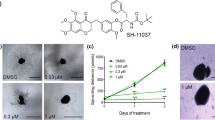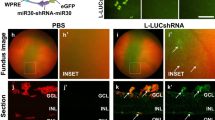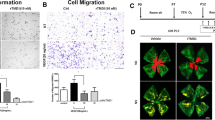Abstract
Purpose
KH902 is a fusion protein derived from the extracellular domains of vascular endothelial growth factor (VEGF) receptors 1 and 2 and the Fc portion of immunoglobulin G1 (IgG1). Retinopathy of prematurity (ROP) is an eye disease that affects premature babies who have received intensive neonatal care, and the disorganization of retinal blood vessels may result in scarring and retinal detachment. This study was designed to examine the inhibitory effects of KH902 on mice with oxygen-induced retinopathy (OIR), one of the animal models of ROP.
Methods
Human umbilical vein endothelial cells (HUVECs) were used for an in vitro study, and the C57BL/6 J OIR mouse model was used for an in vivo study. HUVECs were incubated with KH902 or a VEGF- and KH902-containing medium. Cell proliferation, migration, apoptosis, and tube formation were measured with BrdU incorporation, Transwell, flow cytometry, and Matrigel assays. C57BL/6 J mice were exposed to 75 % oxygen from postnatal day 7 (P7) to P12, after which the mice were brought to room air and intravitreously injected with KH902. At P18, the mice were perfused with fluorescein isothiocyanate (FITC)-dextran and Evans Blue, and flat-mounted retinas were used to measure the non-perfused and leakage areas. The data were analyzed with GraphPad Prism 5.0 software.
Results
In vitro, KH902 dose-dependently inhibited HUVEC proliferation in general culture medium and in VEGF165-containing medium at different time points. Moreover, KH902 inhibited HUVEC migration and tube formation and induced HUVEC apoptosis. In vivo, an intravitreous injection of KH902 reduced the retinal non-perfused area from 34 % in the control group to 19 % in the treatment group and significantly reduced the retinal leakage area from 18 % to 9 %.
Conclusion
KH902 had marked inhibitory effects on angiogenesis both in vitro and in vivo. These data suggest that KH902 could serve as an innovative pharmaceutical agent to prevent retinal neovascularization (NV) and as a strategy for the treatment of ROP.







Similar content being viewed by others
References
Adamis AP, Miller JW, Bernal MT, D’Amico DJ, Folkman J, Yeo TK, Yeo KT (1994) Increased vascular endothelial growth factor levels in the vitreous of eyes with proliferative diabetic retinopathy. Am J Ophthalmol 118:445–450
Aiello LP, Avery RL, Arrigg PG, Keyt BA, Jampel HD, Shah ST, Pasquale LR, Thieme H, Iwamoto MA, Park JE, Nguyen HV, Aiello LM, Ferrara N, King GL (1994) Vascular endothelial growth factor in ocular fluid of patients with diabetic retinopathy and other retinal disorders. N Engl J Med 331:1480–1487
Malecaze F, Clamens S, Simorre-Pinatel V, Mathis A, Chollet P, Favard C, Bayard F, Plouet J (1994) Detection of vascular endothelial growth factor messenger RNA and vascular endothelial growth factor-like activity in proliferative diabetic retinopathy. Arch Ophthalmol 112:1476–1482
Pe’er J, Shweiki D, Itin A, Hemo I, Gnessin H, Keshet E (1995) Hypoxia-induced expression of vascular endothelial growth factor by retinal cells is a common factor in neovascularizing ocular diseases. Lab Inv; J Techmethods Path 72:638–645
Miller JW, Adamis AP, Shima DT, D’Amore PA, Moulton RS, O’Reilly MS, Folkman J, Dvorak HF, Brown LF, Berse B, Yeo TK, Yeo KT (1994) Vascular endothelial growth factor/vascular permeability factor is temporally and spatially correlated with ocular angiogenesis in a primate model. Am J Pathol 145:574–584
Pierce EA, Avery RL, Foley ED, Aiello LP, Smith LE (1995) Vascular endothelial growth factor/vascular permeability factor expression in a mouse model of retinal neovascularization. Proc Natl Acad Sci U S A 92:905–909
Smith LE (2004) Pathogenesis of retinopathy of prematurity. Growth hormone & IGF research: official journal of the Growth Hormone Research Society and the International IGF Research Society 14 Suppl A: S140-144
Chiang MF, Arons RR, Flynn JT, Starren JB (2004) Incidence of retinopathy of prematurity from 1996 to 2000: analysis of a comprehensive New York state patient database. Ophthalmology 111:1317–1325
(1996) Multicenter trial of cryotherapy for retinopathy of prematurity. Snellen visual acuity and structural outcome at 5 1/2 years after randomization. Cryotherapy for Retinopathy of Prematurity Cooperative Group. Archives of ophthalmology 114: 417–424
(2001) Multicenter Trial of Cryotherapy for Retinopathy of Prematurity: ophthalmological outcomes at 10 years. Archives of ophthalmology 119: 1110–1118
Teng LS, Jin KT, He KF, Wang HH, Cao J, Yu DC (2010) Advances in combination of antiangiogenic agents targeting VEGF-binding and conventional chemotherapy and radiation for cancer treatment. J Chin Med Assoc: JCMA 73:281–288
Jin K, He K, Teng F, Li G, Wang H, Han N, Xu Z, Cao J, Wu J, Yu D, Teng L (2011) FP3: a novel VEGF blocker with antiangiogenic effects in vitro and antitumour effects in vivo. Clin Transl Oncol: Off Publ Fed Span Oncol Soc National Cancer Inst Mex 13:878–884
Zhang M, Zhang J, Yan M, Li H, Yang C, Yu D (2008) Recombinant anti-vascular endothelial growth factor fusion protein efficiently suppresses choridal neovasularization in monkeys. Mol Vis 14:37–49
Zhang M, Yu D, Yang C, Xia Q, Li W, Liu B, Li H (2009) The pharmacology study of a new recombinant human VEGF receptor-fc fusion protein on experimental choroidal neovascularization. Pharm Res 26:204–210
Zhang M, Zhang J, Yan M, Luo D, Zhu W, Kaiser PK, Yu DC (2011) A phase 1 study of KH902, a vascular endothelial growth factor receptor decoy, for exudative age-related macular degeneration. Ophthalmology 118:672–678
Bai YJ, Huang LZ, Xu XL, Du W, Zhou AY, Yu WZ, Li XX (2012) Polyethylene glycol-modified pigment epithelial-derived factor: new prospects for treatment of retinal neovascularization. J Pharmacol Exp Ther 342:131–139
Smith LE, Wesolowski E, McLellan A, Kostyk SK, D’Amato R, Sullivan R, D’Amore PA (1994) Oxygen-induced retinopathy in the mouse. Investig Ophthalmol Vis Sci 35:101–111
Zhou GHYW, Li XX (2007) Expression of Cathepsin B in the development of retinal neovascularization. Chin J of Exp Ophthalmol 25
Du W, Yu W, Huang L, Zhao M, Li X (2012) Ephrin-a4 is involved in retinal neovascularization by regulating the VEGF signaling pathway. Investig Ophthalmol Vis Sci 53:1990–1998
Chen J, Connor KM, Aderman CM, Smith LE (2008) Erythropoietin deficiency decreases vascular stability in mice. J Clin Invest 118:526–533
Pierce EA, Foley ED, Smith LE (1996) Regulation of vascular endothelial growth factor by oxygen in a model of retinopathy of prematurity. Arch Ophthalmol 114:1219–1228
Chen J, Smith LE (2007) Retinopathy of prematurity. Angiogenesis 10:133–140
Nonobe NI, Kachi S, Kondo M, Takai Y, Takemoto K, Nakayama A, Hayakawa M, Terasaki H (2009) Concentration of vascular endothelial growth factor in aqueous humor of eyes with advanced retinopathy of prematurity before and after intravitreal injection of bevacizumab. Retina 29:579–585
Mintz-Hittner HA (2012) Intravitreal pegaptanib as adjunctive treatment for stage 3+ ROP shown to be effective in a prospective, randomized, controlled multicenter clinical trial. Eur J Ophthalmol 22:685–686
Carneiro AM, Mendonca LS, Falcao MS, Fonseca SL, Brandao EM, Falcao-Reis FM (2012) Comparative study of 1+PRN ranibizumab versus bevacizumab in the clinical setting. Clin Ophthalmol 6:1149–1157
Lai TY, Luk FO, Lee GK, Lam DS (2012) Long-term outcome of intravitreal anti-vascular endothelial growth factor therapy with bevacizumab or ranibizumab as primary treatment for subfoveal myopic choroidal neovascularization. Eye (Lond) 26:1004–1011
Suto K, Yamazaki Y, Morita T, Mizuno H (2005) Crystal structures of novel vascular endothelial growth factors (VEGF) from snake venoms: insight into selective VEGF binding to kinase insert domain-containing receptor but not to fms-like tyrosine kinase-1. J Biol Chem 280:2126–2131
Miura S, Matsuo Y, Saku K (2008) Jun N-terminal kinase inhibitor blocks angiogenesis by blocking VEGF secretion and an MMP pathway. J Atheroscler Thromb 15:69–74
Yu J, Bian D, Mahanivong C, Cheng RK, Zhou W, Huang S (2004) p38 Mitogen-activated protein kinase regulation of endothelial cell migration depends on urokinase plasminogen activator expression. J Biol Chem 279:50446–50454
Huang J, Li X, Li M, Li S, Xiao W, Chen X, Cai M, Wu Q, Luo D, Tang S, Luo Y (2012) Effects of intravitreal injection of KH902, a vascular endothelial growth factor receptor decoy, on the retinas of streptozotocin-induced diabetic rats. Diabetes Obes Metab 14:644–653
Yu DC, Lee JS, Yoo JY, Shin H, Deng H, Wei Y, Yun CO (2012) Soluble vascular endothelial growth factor decoy receptor FP3 exerts potent antiangiogenic effects. Mol Ther: J Am Soc Gene Ther 20:938–947
Li H, Lei N, Zhang M, Li Y, Xiao H, Hao X (2012) Pharmacokinetics of a long-lasting anti-VEGF fusion protein in rabbit. Exp Eye Res 97:154–159
Acknowledgments
We thank Xin Yu, PhD, for her help with Flow Cytometry detection. This work was supported by the Peking University People’s Hospital Research and Development Fund for BYJ (RDB2012-24) and the National Basic Research Program of China (973 Program, 2011CB510200).
Disclosures
There is no conflict of interest regarding the topic of drug development with Kanghong Pharmaceuticals Group Co., Ltd.
Author information
Authors and Affiliations
Corresponding author
Additional information
Fei Wang and Yujing Bai contributed equally to this paper
Rights and permissions
About this article
Cite this article
Wang, F., Bai, Y., Yu, W. et al. Anti-angiogenic effect of KH902 on retinal neovascularization. Graefes Arch Clin Exp Ophthalmol 251, 2131–2139 (2013). https://doi.org/10.1007/s00417-013-2392-6
Received:
Revised:
Accepted:
Published:
Issue Date:
DOI: https://doi.org/10.1007/s00417-013-2392-6




